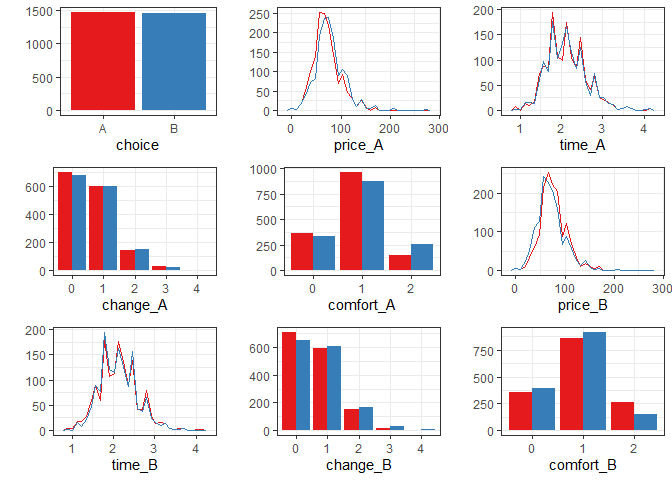
The hardware and bandwidth for this mirror is donated by METANET, the Webhosting and Full Service-Cloud Provider.
If you wish to report a bug, or if you are interested in having us mirror your free-software or open-source project, please feel free to contact us at mirror[@]metanet.ch.

{RprobitB} is an R package for modeling and explaining
choices among discrete alternatives.
The package name is a portmanteau, combining R (the programming language), probit (the model class) and B (for Bayesian, the estimation method).
The package is documented in several vignettes, see here.
You can install the released version of {RprobitB} from
CRAN with:
install.packages("RprobitB")Next, load it via:
library("RprobitB")
#> Thanks for using {RprobitB} version 1.2.0, happy choice modeling!
#> Documentation: https://loelschlaeger.de/RprobitBWe analyze a data set of 2929 stated choices by 235 Dutch individuals deciding between two virtual train trip options based on the price, the travel time, the level of comfort, and the number of changes.
The following lines fit a probit model that explains the chosen trip
alternatives (choice) by their price,
time, number of changes, and level of
comfort (the lower this value the higher the comfort). For
normalization, the price coefficient is fixed to
-1, which allows to interpret the other coefficients as
monetary values:
form <- choice ~ price + time + change + comfort | 0
data <- prepare_data(form, train_choice, id = "deciderID", idc = "occasionID")
plot(data, by_choice = TRUE)
model <- fit_model(data, scale = "price := -1")The summary method provides summary statistics about the Gibbs samples:
FUN <- c("mean" = mean, "mode" = mode_approx, "sd" = stats::sd, "R^" = R_hat)
summary(model, FUN = FUN)
#> Probit model
#> Formula: choice ~ price + time + change + comfort | 0
#> R: 1000, B: 500, Q: 1
#> Level: Utility differences with respect to alternative 'B'.
#> Scale: Coefficient of effect 'price' (alpha_1) fixed to -1.
#>
#> Gibbs sample statistics
#> mean mode sd R^
#> alpha
#>
#> 1 -1.00 -1.00 0.00 1.00
#> 2 -25.84 -25.86 2.18 1.00
#> 3 -4.96 -4.85 0.81 1.00
#> 4 -14.36 -14.64 0.89 1.00
#>
#> Sigma
#>
#> 1,1 648.51 622.88 63.32 1.00The estimated effects obtained from the Gibbs sample means can be visualized via:
coef(model) |> plot()
The results indicate that the deciders value one hour travel time by about 25€, an additional change by 5€, and a more comfortable class by 15€.
Now assume that a train company wants to anticipate the effect of a price increase on their market share. By our model, increasing the ticket price from 100€ to 110€ (ceteris paribus) draws 15% of the customers to the competitor who does not increase their prices:
new_prices <- data.frame(
"price_A" = c(100, 110), "price_B" = c(100, 100)
)
predict(model, data = new_prices, overview = FALSE)
#> deciderID occasionID A B prediction
#> 1 1 1 0.50 0.50 A
#> 2 2 1 0.35 0.65 BHowever, offering a better comfort class (0 here is
better than 1) compensates for the higher price and even
results in a gain of 7% market share:
new_comfort <- data.frame(
"price_A" = c(100, 110), "comfort_A" = c(1, 0),
"price_B" = c(100, 100), "comfort_B" = c(1, 1)
)
predict(model, data = new_comfort, overview = FALSE)
#> deciderID occasionID A B prediction
#> 1 1 1 0.50 0.50 A
#> 2 2 1 0.57 0.43 AThese binaries (installable software) and packages are in development.
They may not be fully stable and should be used with caution. We make no claims about them.